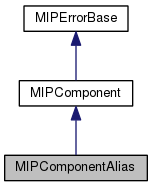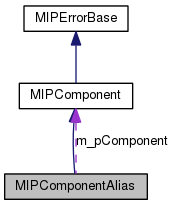This class provides a wrapper around another component, essentially providing a different pointer to the same object. More...
#include <mipcomponentalias.h>


Public Member Functions | |
| MIPComponentAlias (MIPComponent *pComp) | |
Create a component alias for component pComp. | |
Detailed Description
This class provides a wrapper around another component, essentially providing a different pointer to the same object.
In the documentation on the main page, the following example was used to illustrate how different branches in a chain may merge again:

It was also explained why the following chain was not a good choice, as it can cause some synchronization problems:

The basic problem was that in this case the lengths of the branches are not equal, which can cause a packet being extracted from the audio mixer before the sampling rate converter passes another packet to this mixer. To solve this, either the first chain shown above can be used, or a MIPComponentAlias can be used:

In this chain, the alias is simply a wrapper around the previous soundfile input component, and the dotted connection indicates that we won't really be passing any messages between the component and its alias (so we won't send messages from the component to itself). The link from the component alias to the mixer will then effectively pass messages from the soundfile input component to the mixer. The subchains now have an equal length, avoiding the synchronization problem mentioned earlier.
Here is some code which illustrates how this is done, the full source code can be found in examples/multiplesoundfileplayer.cpp , in which the effect of the other two chains can be heard as well. First, we'll define the components in the chain:
MIPTime interval(1.000); // one second intervals MIPAverageTimer timer(interval); MIPWAVInput sndFileInput2; MIPComponentAlias alias(&sndFileInput2); MIPWAVInput sndFileInput1; MIPSamplingRateConverter sampConv; MIPAudioMixer mixer; MIPSampleEncoder sampEnc; #ifndef WIN32 MIPOSSInputOutput sndCardOutput; #else MIPWinMMOutput sndCardOutput; #endif
As you can see, we have specified that a component named 'alias' will actually refer to one of the soundfile input components. Then, we shall build the chain by specifying the start component and the connections in the chain:
returnValue = chain.setChainStart(&timer);
checkError(returnValue, chain);
returnValue = chain.addConnection(&timer, &sndFileInput1);
checkError(returnValue, chain);
returnValue = chain.addConnection(&timer, &sndFileInput2);
checkError(returnValue, chain);
returnValue = chain.addConnection(&sndFileInput1, &sampConv);
checkError(returnValue, chain);
returnValue = chain.addConnection(&sndFileInput2, &alias, false, 0, 0);
checkError(returnValue, chain);
returnValue = chain.addConnection(&sampConv, &mixer);
checkError(returnValue, chain);
returnValue = chain.addConnection(&alias, &mixer);
checkError(returnValue, chain);
returnValue = chain.addConnection(&mixer, &sampEnc);
checkError(returnValue, chain);
returnValue = chain.addConnection(&sampEnc, &sndCardOutput);
checkError(returnValue, chain);
Note that in specifying the connection from the soundfile input component to its alias, the last two parameters of MIPComponentChain::addConnection have been set to zero. This will make sure that no messages are passed from the soundfile component to its alias.
Now you may wonder why a construction with an alias is necessary, why it's not possible to simply use the component itself. Suppose we would not use the alias, and we would use the following connections:
returnValue = chain.addConnection(&timer, &sndFileInput2);
checkError(returnValue, chain);
returnValue = chain.addConnection(&sndFileInput2, &sndFileInput2, false, 0, 0);
checkError(returnValue, chain);
returnValue = chain.addConnection(&sndFileInput2, &mixer);
checkError(returnValue, chain);
In that case we would not create subchains of equal length, but effectively the following situation would be created:

In this chain, it is of course still possible that the same synchronization problem occurs.
Constructor & Destructor Documentation
| MIPComponentAlias::MIPComponentAlias | ( | MIPComponent * | pComp | ) | [inline] |
The documentation for this class was generated from the following file:
- src/core/mipcomponentalias.h
 1.7.3
1.7.3